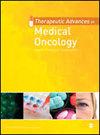Pharmacokinetics, safety, and efficacy of an alternative dosing regimen of sasanlimab in participants with advanced NSCLC and other malignancies.
IF 4.3
2区 医学
Q2 ONCOLOGY
引用次数: 0
Abstract
Background Sasanlimab (PF-06801591), a humanized immunoglobulin G4 monoclonal antibody, binds to programmed cell death protein-1 (PD-1), preventing ligand (PD-L1) interaction. Objectives To evaluate pharmacokinetics (PK), safety, tolerability, and efficacy of two subcutaneous sasanlimab dosing regimens. Design An open-label study consisting of phases Ib and II. Phase Ib: non-randomized, dose escalation, and expansion study in Asian participants with advanced malignancies. Phase II conducted globally in participants with non-small-cell lung cancer with PD-L1 positive or PD-L1 status unknown tumors; participants were randomized 1:2 to receive subcutaneous sasanlimab 300 mg once every 4 weeks (300 mg-Q4W) or 600 mg once every 6 weeks (600 mg-Q6W). Methods Primary endpoint in phase Ib: dose-limiting toxicity (DLT) occurring in first treatment cycle; in phase II: C trough and AUC. Results A total of 155 participants (phase Ib, n = 34; phase II, n = 121) received sasanlimab. Phase Ib: no DLT reported. Phase II: ratio of adjusted geometric mean for AUCtau was 231.2 (90% CI, 190.1-281.2) and C trough was 111.5 (90% CI, 86.3-144.0) following 600 mg-Q6W (test) versus 300 mg-Q4W (reference). Phase Ib: grade 3 treatment-related adverse events (TRAEs) occurred in 1/4 (25%) and 3/12 (25%) participants treated in 300 mg-Q4W dose escalation and expansion cohorts, respectively. Phase II: grade 3 TRAEs occurred in 3/41 (7.3%) and 3/80 (3.8%) participants treated with 300 mg-Q4W and 600 mg-Q6W, respectively; no grade 4/5 TRAEs. Phase II: confirmed objective response was observed in 11/41 (26.8% (95% CI, 14.2-42.9)) and 12/80 (15.0% (95% CI, 8.0-24.7)) participants treated with 300 mg-Q4W and 600 mg-Q6W, respectively. Conclusions Phase Ib regimens were considered safe with no DLTs reported. In phase II, 600 mg-Q6W regimen criteria were met for AUCtau and C trough metrics to support PK-based extrapolation of efficacy of alternative regimen. Regimens were well tolerated, showing anti-tumor activity in participants with advanced solid tumors. Administration of sasanlimab at a dose of 600 mg-Q6W subcutaneously may serve as a convenient alternative to 300 mg-Q4W administration. Trial registration NCT04181788 (ClinicalTrials.gov); 2019-003818-14 (EudraCT).在晚期非小细胞肺癌和其他恶性肿瘤患者中使用沙生利单抗替代给药方案的药代动力学、安全性和疗效。
背景沙生利单抗(PF-06801591)是一种人源化免疫球蛋白G4单克隆抗体,可与程序性细胞死亡蛋白-1(PD-1)结合,防止配体(PD-L1)相互作用。目标评估两种皮下注射沙生利单抗给药方案的药代动力学(PK)、安全性、耐受性和疗效。Ib期:在亚洲晚期恶性肿瘤患者中开展的非随机、剂量递增和扩大研究。II期在全球范围内开展,研究对象为PD-L1阳性或PD-L1状态未知的非小细胞肺癌患者;参与者按1:2的比例随机接受皮下注射沙生利单抗300毫克,每4周一次(300毫克-Q4W)或600毫克,每6周一次(600毫克-Q6W)。方法Ib期主要终点:第一个治疗周期出现的剂量限制性毒性(DLT);II期主要终点:C谷值和AUC。结果共有155名参与者(Ib期,34人;II期,121人)接受了沙生利单抗治疗。Ib期:无DLT报告。II期:600 mg-Q6W(试验)与300 mg-Q4W(参考)相比,AUCtau的调整几何平均比为231.2(90% CI,190.1-281.2),C trough的调整几何平均比为111.5(90% CI,86.3-144.0)。Ib期:在300 mg-Q4W剂量升级组和扩大组中,分别有1/4(25%)和3/12(25%)名参与者出现3级治疗相关不良事件(TRAE)。II期:分别有3/41(7.3%)和3/80(3.8%)名接受300 mg-Q4W和600 mg-Q6W治疗的患者出现3级TRAE;没有出现4/5级TRAE。II期:接受300 mg-Q4W和600 mg-Q6W治疗的患者中,分别有11/41(26.8%(95% CI,14.2-42.9))和12/80(15.0%(95% CI,8.0-24.7))人观察到了确诊的客观反应。在II期治疗中,600 mg-Q6W治疗方案的AUCtau和C trough指标均符合标准,支持基于PK的替代治疗方案疗效外推。疗程耐受性良好,在晚期实体瘤患者中显示出抗肿瘤活性。以600毫克-Q6W的剂量皮下注射沙生利单抗可作为300毫克-Q4W给药的方便替代方案。
本文章由计算机程序翻译,如有差异,请以英文原文为准。
求助全文
约1分钟内获得全文
求助全文
来源期刊

Therapeutic Advances in Medical Oncology
ONCOLOGY-
CiteScore
8.20
自引率
2.00%
发文量
160
审稿时长
15 weeks
期刊介绍:
Therapeutic Advances in Medical Oncology is an open access, peer-reviewed journal delivering the highest quality articles, reviews, and scholarly comment on pioneering efforts and innovative studies in the medical treatment of cancer. The journal has a strong clinical and pharmacological focus and is aimed at clinicians and researchers in medical oncology, providing a forum in print and online for publishing the highest quality articles in this area. This journal is a member of the Committee on Publication Ethics (COPE).
 求助内容:
求助内容: 应助结果提醒方式:
应助结果提醒方式:


